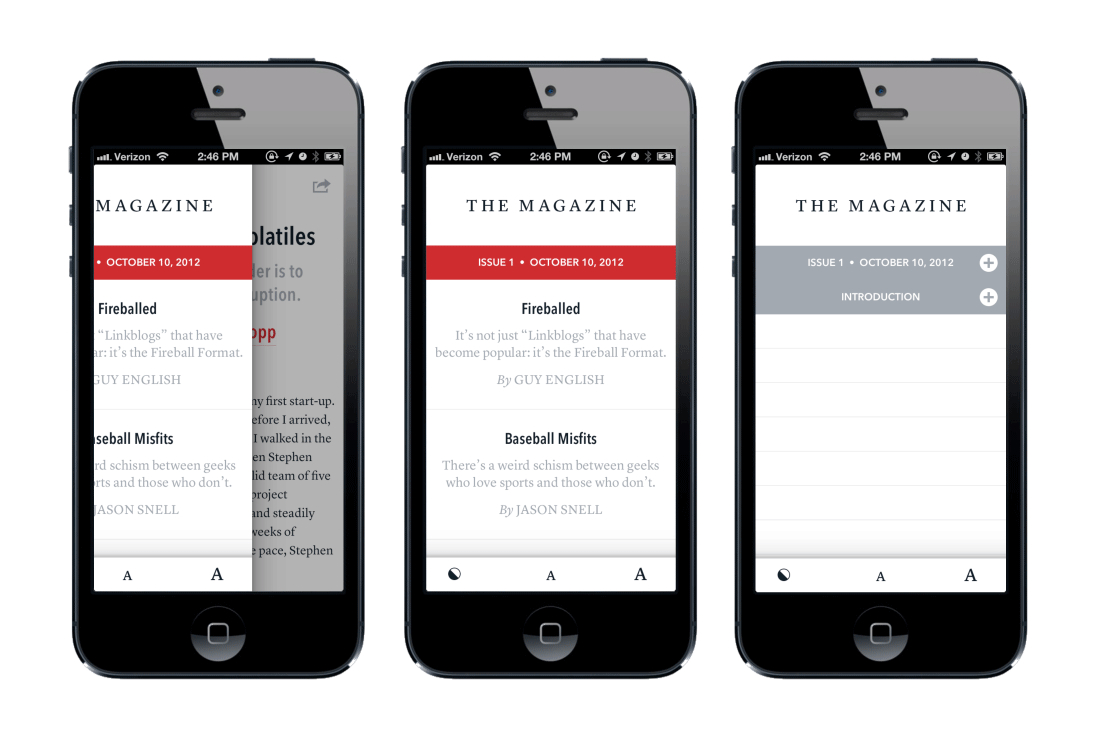How To Publish a "Minimum Viable Magazine" Online
Shocking no one, News Corporation’s iPad-only publication “The Daily” kicked the bucket today. While future-of-journalism sites ponder the why’s and wherefores, technologists like Marco Arment and Craig Mod may have already identified a working alternative. Their connections to the journalism or publishing “industry” as we’ve understood it for the past century are tenuous at best–Arment is a programmer who built Tumblr and Instapaper, while Mod was a product designer at Flipboard. And that outsider status is precisely why they’re onto something.

Web startups live and die by a strategy called the MVP, or “minimum viable product.” Arment has applied that philosophy to digital publishing in his publication The Magazine, which launched in October. On one hand, The Magazine is very much like The Daily: it’s a paid app, available only on iOS devices (via Apple’s awkward Newsstand storefront), and it’s emphatically a business enterprise rather than an artsy labor of love (Arment has promised to shutter the app if it doesn’t turn a profit after four issues).
On the other, it’s as opposite from Rupert Murdoch’s app as antimatter is from matter. Sure, The Daily tried to be USA Today on the iPad while The Magazine is basically McSweeney’s for tech nerds–but those differences are skin deep. What makes Arment’s app work–and what could make it a sustainable model for other, more ambitious publications–has everything to do with practicalities of technology, infrastructure, and user experience, not the free-floating abstraction called “journalism”. Mod unfurls these insights in a must-read essay, but here’s a distillation of how to build an MVP (minimum viable publishing) operation:
- Make it simple so you can make it fast. “Immersive reading experiences” are fine and dandy, but nobody wants to wait for a multi-gigabyte download. Optimize your publication for speed. That means text, not interactive doodads; scrolling single column layouts, not pagination and flashy nav schemes; and small bundles of similarly-sized features, not a print-like stack of sections surrounding a “feature well.” Think Instagram, not Photoshop.
- Make it open (enough). Base the thing on HTML so it’s simple, i.e. fast, but also futureproof. This also ensures that every piece of content has “a corresponding, touchable home on the open web”, as Mod puts it; even though the app is paid, “content without a public address is non-existent in the eyes of all the inter-operable sharing mechanisms that together bind the web.”
- Exploit a seamless purchasing pipeline. Only an iOS developer like Arment could truly grok the possibilities of something like Newsstand, argues Mod. It’s basically RSS but better: readers can try before they buy, and once they buy, they pay once and then new content frictionlessly and instantly flows into the publication. There’s no thinking (“hm, is this one article worth the money?”) and no waiting (Newsstand pushes new content to your device in the background, so it’s already there when you decide to read it).
If none of this sounds like rocket science, that’s exactly the point. It’s nothing more than savvy digital development and product design strategies applied to a publishing context. Every other digital publisher is doing the reverse: starting with (legacy) publishing strategies and backing into the technology–which leads to bloated, unsustainable operations and user experiences that never feel essential enough to compete with the free web (or even print). It’s no wonder that a hacker-entrepreneur (who happens to love reading) like Marco Arment was able to prototype publishers’ future right under their own noses. Assuming it works–Issue 4 of The Magazine is out now, and there are no rumblings yet that Marco will be snuffing it out–will the Rupert Murdochs of the world be smart enough run with it? Or just keep running away from it?
Keep Reading
Most Popular
Large language models can do jaw-dropping things. But nobody knows exactly why.
And that's a problem. Figuring it out is one of the biggest scientific puzzles of our time and a crucial step towards controlling more powerful future models.
How scientists traced a mysterious covid case back to six toilets
When wastewater surveillance turns into a hunt for a single infected individual, the ethics get tricky.
The problem with plug-in hybrids? Their drivers.
Plug-in hybrids are often sold as a transition to EVs, but new data from Europe shows we’re still underestimating the emissions they produce.
Google DeepMind’s new generative model makes Super Mario–like games from scratch
Genie learns how to control games by watching hours and hours of video. It could help train next-gen robots too.
Stay connected
Get the latest updates from
MIT Technology Review
Discover special offers, top stories, upcoming events, and more.